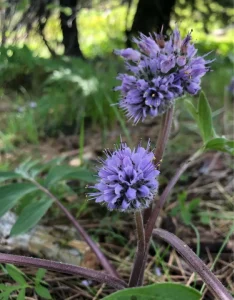
Hydrophyllum
Basic Information Common Name: Hydrophyllum Scientific Name: Hydrophyllum Native Habitat: Moist woodlands and stream banks of eastern North America. History / Discovery / Cultivator Hydrophyllum,
Common Name: Hydrophyllum
Scientific Name: Hydrophyllum
Native Habitat: Moist woodlands and stream banks of eastern North America.
Hydrophyllum, commonly known as Waterleaf, belongs to the Boraginaceae family (formerly Hydrophyllaceae). The name “Hydrophyllum” comes from the Greek words “hydro” (water) and “phyllon” (leaf), referring to the water-holding properties of some species’ leaves and their preference for moist habitats. The genus includes several species, each with its distinct characteristics and distribution.
The exact moment of “discovery” in a scientific context is difficult to pinpoint, as indigenous peoples in North America undoubtedly knew and utilized these plants long before European botanists arrived. However, formal botanical classification and documentation likely began in the 18th and 19th centuries with the exploration and cataloging of North American flora. Prominent botanists of the era, such as Carl Linnaeus (although he may not have directly described Hydrophyllum, his system laid the foundation), and later, American botanists like Asa Gray, would have contributed to the identification and naming of Hydrophyllum species.
The plant’s historical uses are tied to its presence in woodland ecosystems. Native American tribes utilized various Hydrophyllum species for medicinal purposes. The leaves were sometimes used as poultices or consumed to treat various ailments. Details regarding specific tribal uses can vary based on the specific species and geographic location. Further ethnobotanical research can provide more specific insights.
While not actively “cultivated” in the modern agricultural sense for widespread food production or ornamental purposes, Hydrophyllum species have found a niche in native plant gardening and ecological restoration projects. These projects aim to re-establish native plant communities in disturbed areas, providing habitat for wildlife and promoting biodiversity. Nurseries specializing in native plants may propagate and offer Hydrophyllum species for these purposes. Gardeners appreciate them for their attractive foliage, delicate flowers, and ability to thrive in shady, moist conditions. Interest in native plants has been increasing, so Hydrophyllum is seeing more cultivation recently.
The geographical origins of Hydrophyllum are rooted in eastern North America. Species diversity is centered in the eastern United States, although some species extend into parts of Canada. Their presence is indicative of healthy, undisturbed woodland ecosystems, making them important indicators of environmental quality. Conservation efforts focused on protecting these habitats indirectly benefit Hydrophyllum populations. The plant’s distribution is tied to the availability of suitable moist conditions, making it vulnerable to habitat loss from deforestation and changes in hydrology.
| Category | General Requirement | Notes |
|---|---|---|
| Light | Partial Shade | Prefers dappled sunlight or shade; avoid direct afternoon sun. |
| Water | Consistent Moisture | Keep soil consistently moist, especially during dry periods. |
| Humidity | Moderate | Benefits from higher humidity levels. |
| Temp. Range | Cool to Moderate | Tolerates a range of temperatures, avoid extreme heat. |
| Soil Type | Rich, Moist, Well-Drained | Loamy soil amended with organic matter is ideal. |
| Fertilizer | Light Feeding | Apply a balanced liquid fertilizer sparingly during the growing season. |
| Toxicity | Non-toxic | Generally considered non-toxic to humans and pets. |
Hydrophyllum species exhibit several adaptations suited to their woodland habitat. Their broad leaves efficiently capture sunlight in the shaded understory. The “waterleaf” characteristic in some species refers to the way the leaves can collect and hold rainwater, potentially providing a small reservoir for the plant or attracting insects. The plant’s rhizomatous root system allows it to spread vegetatively, forming colonies and stabilizing soil. The flowers are adapted for pollination by various insects, often having nectar guides and offering pollen rewards. The preference for moist environments reflects its need for consistent access to water.
Hydrophyllum can be propagated through several methods:
Hydrophyllum species are generally considered non-toxic to humans and pets. While ingestion may cause mild gastrointestinal upset in rare cases, serious adverse effects are not expected. As with any plant, it is advisable to prevent excessive consumption.
While not globally endangered, some Hydrophyllum species may be locally rare or threatened due to habitat loss and fragmentation. The plant’s reliance on specific woodland conditions makes it vulnerable to deforestation, development, and changes in hydrology. Also, Hydrophyllum plants may not always be available for sale due to the limited popularity of native plants in typical ornamental nurseries.
The value of Hydrophyllum plants is primarily associated with their use in native plant gardening and ecological restoration projects. Factors influencing value include:

Basic Information Common Name: Hydrophyllum Scientific Name: Hydrophyllum Native Habitat: Moist woodlands and stream banks of eastern North America. History / Discovery / Cultivator Hydrophyllum,
